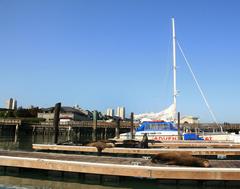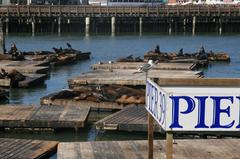
Pier 39 Sea Lions: Visiting Hours, Tickets, and San Francisco Historical Sites Guide
Date: 14/06/2025
Introduction
Pier 39 in San Francisco is a dynamic waterfront destination, famously home to a thriving colony of California sea lions that have captivated visitors since 1989. Their spontaneous arrival following the Loma Prieta earthquake transformed the site into a symbol of resilience and ecological vitality. Today, Pier 39’s sea lion docks offer a unique blend of urban excitement, wildlife viewing, and educational opportunities, drawing millions of visitors annually. This comprehensive guide details the history, practical visitor information, conservation initiatives, and nearby attractions, ensuring you make the most of your visit to this iconic San Francisco landmark (Pier 39 Marina; LA Times; Marine Mammal Center).
Table of Contents
- Origins and Growth of the Sea Lion Colony
- Visiting Pier 39: Hours, Tickets, and Accessibility
- Seasonal Patterns and Population Trends
- Conservation, Education, and Environmental Stewardship
- Nearby Historical Sites and Attractions
- Frequently Asked Questions (FAQ)
- Practical Tips for a Memorable Visit
- Summary and Conclusion
- References
Origins and Growth of the Sea Lion Colony
The California sea lions first appeared at Pier 39 in the aftermath of the 1989 Loma Prieta earthquake. With marina docks temporarily vacated for repairs and an abundance of food in the bay, sea lions found a perfect haul-out site on Pier 39’s floating K-Dock (Fisherman’s Wharf). What started with a single large male in December 1989 soon grew to over 300 sea lions by early 1990. Initial concerns over noise and odor gave way to widespread appreciation as the sea lions attracted global media attention and revitalized tourism at Fisherman’s Wharf (NPR).
The Marine Mammal Center advised marina officials to let the sea lions remain, launching a unique example of urban human-wildlife coexistence. The colony’s growth has since established the sea lions as an enduring symbol of San Francisco’s waterfront (Pier 39 History).
Visiting Pier 39: Hours, Tickets, and Accessibility
Visiting Hours
Pier 39 is open 24 hours as an open-air complex, although shops, restaurants, and attractions generally operate from 10:00 a.m. to 9:00 p.m. or later, depending on season. The sea lions can be viewed throughout the day, with the best activity during early morning and late afternoon, particularly in winter and spring (Pier Market).
Tickets and Admission
Viewing the sea lions is entirely free—no tickets are required to access the sea lion docks or viewing platforms. Some attractions within Pier 39, such as the Aquarium of the Bay or select rides, may require separate admission.
Accessibility
The pier’s main walkways, viewing platforms, and the Sea Lion Center are wheelchair accessible, with ramps and smooth pathways. Service animals are welcome; other pets are not permitted due to high visitor traffic (Fisherman’s Wharf).
Getting There
Pier 39 is located at Beach Street & The Embarcadero, San Francisco, CA 94133. It is easily accessible by public transportation, including Muni buses and the historic F-Line streetcars. Parking is available but can be limited and expensive; public transit is recommended (Fisherman’s Wharf).
Seasonal Patterns and Population Trends
Sea lion numbers at Pier 39 fluctuate with the seasons and food supply. Peak populations, sometimes exceeding 2,000 individuals, are typically observed from late fall through mid-May, coinciding with anchovy and herring runs in the bay (San Francisco Jeep Tours). During June and July, many adult males migrate south for breeding, resulting in fewer sea lions on the docks. However, a resident population remains year-round, and the best viewing is often in winter and spring (Pier 39 Sea Lion Webcam).
Conservation, Education, and Environmental Stewardship
Conservation Initiatives
The Marine Mammal Center is instrumental in protecting Pier 39’s sea lions, providing rescue, rehabilitation, and research for sick or injured animals. Plastic pollution, entanglement in fishing gear, and fluctuations in food supply remain ongoing threats (San Francisco Jeep Tours; Popular Science). Partnerships with organizations like NOAA Fisheries and local environmental groups support research, public outreach, and habitat protection (Marine Mammal Center).
Educational Programs
The Sea Lion Center, operated by Aquarium of the Bay and the Marine Mammal Center, offers interactive exhibits and educational talks about sea lion biology, migration, and conservation. A new permanent pop-up exhibit launched in 2023 further enhances on-site learning (NBC Bay Area). Digital resources, including a live sea lion webcam, expand access for remote visitors and schools.
Visitor Guidelines
- Observe sea lions from designated platforms; do not touch, feed, or disturb them.
- Remain behind railings and keep noise to a minimum.
- Supervise children and respect wildlife at all times (City Experiences).
Nearby Historical Sites and Attractions
- Fisherman’s Wharf: A renowned destination for seafood, shops, and maritime history.
- Alcatraz Island: The legendary former prison, accessible by ferry.
- Ghirardelli Square: Historic chocolate factory with shops and dining.
- San Francisco Maritime National Historical Park: Features historic ships and educational exhibits.
- Aquarium of the Bay: Showcasing local marine life, located within Pier 39.
All sites are accessible via public transit or a short walk from Pier 39 (Fisherman’s Wharf).
Frequently Asked Questions (FAQ)
When are the sea lions most active?
Early morning and late afternoon, especially in winter and spring.
Is there an admission fee to see the sea lions?
No, sea lion viewing at Pier 39 is free.
Are pets allowed?
Only service animals are permitted.
Is Pier 39 wheelchair accessible?
Yes, all main areas and viewing platforms are accessible.
What are the best months to visit for sea lion viewing?
Late July through mid-May typically has the largest populations.
Practical Tips for a Memorable Visit
- Check the Sea Lion Webcam: For real-time viewing and sea lion counts.
- Dress in Layers: San Francisco’s weather is unpredictable.
- Visit Off-Peak: Early or late in the day for fewer crowds.
- Use Public Transit: Convenient and reduces parking hassles.
- Respect Wildlife: Observe from a distance; never feed or disturb the sea lions.
Summary and Conclusion
The Pier 39 sea lions are a testament to San Francisco’s vibrant natural heritage and the city’s commitment to wildlife conservation. What began as an unexpected phenomenon quickly evolved into a beloved attraction, drawing millions of visitors and revitalizing the waterfront. Through collaborative efforts in conservation, education, and responsible tourism, the sea lions remain a symbol of urban ecological harmony. By visiting Pier 39, you not only experience a unique wildlife spectacle but also support ongoing initiatives to protect marine life and the Bay’s ecosystem. Plan your visit, engage responsibly, and enjoy all that Pier 39 and San Francisco’s waterfront have to offer (Pier 39; NBC Bay Area; Fisherman’s Wharf).
References and Further Reading
- Pier 39 Marina
- LA Times
- Fisherman’s Wharf
- Marine Mammal Center
- Pier 39 Sea Lion Q&A
- San Francisco Jeep Tours
- NBC Bay Area
- City Experiences
- Popular Science
- Pier Market










































































































































































